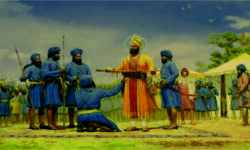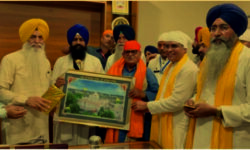Does Bani inspire only through writing? Or can it also be spoken, sung, painted, and acted out? Of course, it can! Bani can be expressed in all those forms. You can speak it, sing it, paint it, and act it out. Bani conveys concepts, emotions, and experiences — and all of these can be represented visually. You can share a range of ideas and emotions through writing, but you can also do the same through pictures.
After all, words themselves evolved from simplified pictures over centuries of human history. While words may now seem disconnected from paintings, their origins are deeply rooted in imagery. Just look at ancient Egyptian hieroglyphics — picture-words arranged like sentences on the walls of the great pyramids. When you see those hieroglyphics, you’re witnessing the evolution of writing from visual art.
So yes, Bani can be painted — not just as calligraphy but as expressive artwork, as living pictures. And if Bani can be painted, then surely the Guru can be painted as well, because the Guru is one with Bani. He is inseparable from his teachings. When someone experiences the teachings of the Guru, they may also get a glimpse of the Guru himself.
I have personally had experiences of Bani that inspired me to paint what I felt. The Guru was a living presence in those moments. In my experiences, it felt as though He was the one experiencing His own teachings — I was merely a witness.
Because they move people.
Both words and paintings can express concepts, emotions, and experiences, but paintings have a unique immediacy. There’s a reason for the saying, “A picture is worth a thousand words.” A painting can instantly capture attention and guide viewers toward a specific feeling or realization. In just one glance, a painting can uplift, inspire, and even teach something profound.
Many of my early paintings were lessons in history. I wanted to teach young people about the extraordinary figures in Sikh history — to present them in a way that would spark curiosity and make viewers want to learn more. To achieve this, I always included a verse of Gurbani and a historical note alongside each painting.
But the long answer goes much deeper.
I became attached to Sikhi, Sikh Art, and Sikh History because I saw paintings by artists like Sobha Singh, Kirpal Singh, Devender Singh, Mehar Singh, Bodh Raj, B. M. Anand, and many others. These artists poured their hearts and souls into their work — and their paintings lit a fire within me at a very young age.
When I was 11, I attended Gurmat, Punjabi, and kirtan classes at a local Gurdwara on Sundays. The principal of the academy, upon learning that I could draw, encouraged me. He bought me paints, brushes, Bristol boards, and canvases. He even gave me small images of historical paintings by Kirpal Singh and asked me to enlarge them onto large boards to hang around the Gurdwara — particularly in the langar hall — so visitors unfamiliar with Sikh history could learn through visual storytelling.
I painted those images during summers and in my free time for several years until the principal resigned from the academy. I haven’t seen him or those paintings in years, but the experience stayed with me forever. That’s how I started learning about Sikh history — through paintings. And now, kirtan and simran keep me going.
All my life experiences, meditations, internal struggles, and all the shabads I’ve read, sung, and contemplated have fueled my passion for painting. I pour all of that into my artwork, hoping viewers might catch a glimpse of that spiritual spark for themselves.
Passion is something everyone can cultivate — no matter their background.
I hope my paintings inspire passion in others. The kind of passion we see in:
-Guru Ramdas Ji, when he composed shabads expressing his intense longing for Hari.
-Sahibzada Ajit Singh, as he charged fearlessly toward the Mughal forces, fighting to his last breath.
-Sahibzada Ajit Singh, as he charged fearlessly toward the Mughal forces, fighting to his last breath.
For me, it’s all about passion — passion for a cause greater than oneself, passion for a higher power, passion for Sikhi, Sikh Art, and Sikh History.








